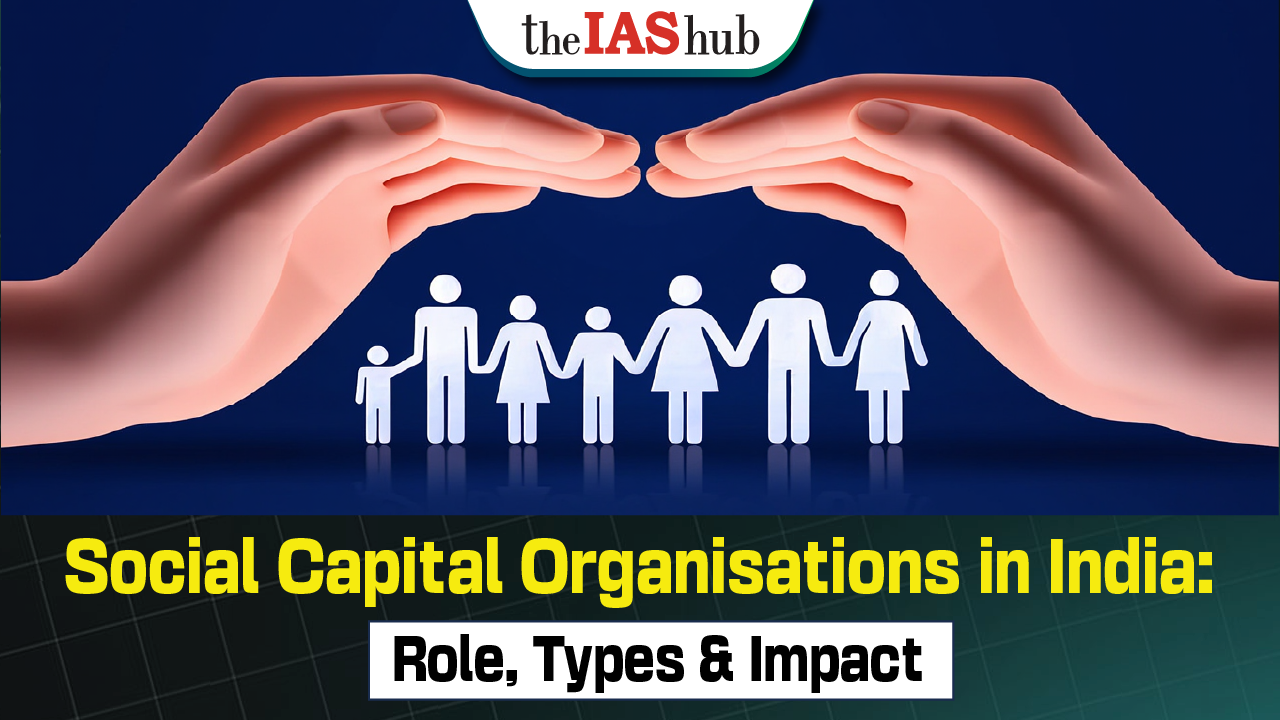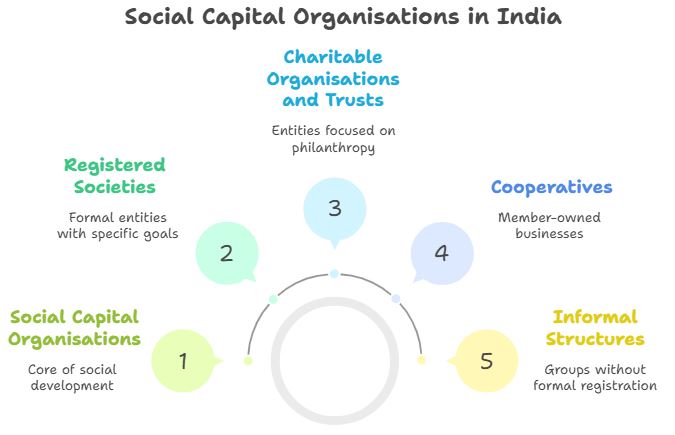Social capital is a valuable asset that facilitates effective collaboration and the achievement of common goals within a group or organization. It is a key element in the functioning of a society, corporation, or non-profit organization, as it fosters trust, shared identity, shared norms and values, and mutual relationships. These aspects collectively contribute to what is often referred to as a civil society, where people can work together harmoniously and productively.
Classification of Social Capital Organisations in India
2nd ARC, based on the laws under which the civil society operate and the kind of activities they take up, classified them as:
- Registered Societies formed for specific purposes
- Charitable organisations and Trusts
- Cooperatives
- Bodies without having any formal organisational structure
- Government promoted Third Sector organisations
- Local Stakeholders Groups, Microcredit and Thrift Enterprises, SHGs Student Government promoted Third Sector organisations
- Professional Self-Regulatory Bodies
Role of Social Capital Organisations in Development Process
Social capital has been a useful conceptual umbrella for networks, group memberships, civic and political participation, and subjective factors like trust in institutions and people.
Social capital organisations, also known as non-profit organisations, are vital to India's growth and social well-being. Socially mission-driven organisations address social, economic, and environmental issues. Indian social capital organisations perform the following:

- Social Services: They may provide healthcare, education, poverty alleviation, women's empowerment, child welfare, and elderly or disabled support. Example NGO- Pratham, Savelife foundation etc.,
- They address socioeconomic inequality: by improving access to quality services for underprivileged groups and distant places with limited government resources. and service gaps.
- Influencing Policy: promote the rights and interests of various socioeconomic groups. They impact policymaking and systemic change. Example Kisan organisations during the Anti farm law protest.
- These organisations conduct research, policy analysis, and advocacy campaigns to promote social issues, policy improvements, and their implementation.
- Example Birdlife India foundation, Savenarmada Movement, etc,
- They monitor governments and institutions and promote inclusive and equitable policies.
- Community Empowerment: They support community-led initiatives, capacity building, and social entrepreneurship.
- Social Innovation: They discover growing social issues, devise novel ways, and test new solutions to challenging situations. Example India against corruption movement.
- Resources and Philanthropy: Social capital organisations fundraise, grant write, and philanthropy.
- They survive and grow on contributions, grants, CSR funds, and collaborations.
- Emergency Relief: They mobilise resources, give immediate help, and aid recovery and rehabilitation following natural disasters, pandemics, and humanitarian crises. They help vulnerable populations recover from calamities.
Indian social capital organisations range from huge national NGOs to community-based ones. They greatly advance social development, address social issues, and promote inclusive and sustainable progress.

National Policy on the “Voluntary Sector” 2007
- Meaning of Voluntary organisation: “Voluntary Organisations (VOs) mean to include organisations engaged in public service, based on ethical, cultural, social, economic, political, religious, spiritual, philanthropic or scientific and technological considerations.
- For example, NGOs, SHGs, Societies, charitable institutions etc.,
|
Societies
|
Charitable institutions
|
- It's a group of people working towards a philanthropic, literary, or scientific goal.
- Society registration is simple: 7 members must sign the MoA (Memorandum of Association) and file it with the ROC (Registrar of Companies).
- The Societies Registration Act, 1860, registers societies.
- Registered by: the Registrar of Company.
- Annually, the Society must submit the names, addresses, and occupations of its Managing Committee members to the Registrar.
|
- It's a single-party entity where the second party holds the first party's assets for the third party.
- The Trustee accepts the Trustor's proposal and manages the Trustor's property for the third party (beneficiary).
- The Trust Deed contains all the terms and conditions of the Trust, which is Trust Property.
- Registered by the Registrar/Deputy Registrar of Societies of the concerned State or Charity Commissioner.
- No need to give any disclosure.
|
Social Capital Organisations: Role of Self-Help Groups (SHGs)
- Self-Help Groups are an untapped powerhouse of women and other marginalised sections of society and highly potential vehicles to deliver social goods.
- It is an informal homogeneous affinity group, with the objective of - Zero Poverty, Zero Unemployment and Sustainable development.
- It can be defined as self-governed, peer-controlled with similar socio-economic backgrounds and having a desire to collectively perform a common purpose.
Advantages of SHGs

- Social integrity – SHGs encourage collective efforts for combating practises like dowry, alcoholism etc.
- Gender Equity – SHGs empower women and inculcate leadership skills among them. Empowered women participate more actively in the Gram Sabha and elections.
- Economic empowerment: Women get self-assurance to take part in decision-making processes both at the household and community levels. Ex. Kudumbashree in Kerala
- Resource mobilisation: SHG initiatives can effectively mobilize underutilized and underused community resources.
- Alternate source of income – SHGs reduce reliance on agriculture by assisting in the establishment of micro businesses.
- For example, individualised businesses like grocers, tailors, and tool repair shops.
- Role Model: Successful SHGs act as resource persons for different community developmental initiatives.
- For Example – Lijjat Papad led to many establishments of many households’ industries.
- Leadership: Active involvement in various SHG initiatives aids members in developing their leadership abilities.
- Ex. Women SHG leaders are frequently selected as candidates for Panchayat Pradhan or as PRI representatives.
- Pressure Groups – Enables women to highlight issues such as dowry, alcoholism, menstrual hygiene, and sanitation etc. and impact policy decisions.
- Voice to marginalised section – Mostly marginalised communities are beneficiary of schemes and hence their participation through SHGs ensures social justice.
- Financial Inclusion – The SHG-Bank linkage Programme pioneered by NABARD has eased credit access and reduced the dependence on traditional money lenders.
- Check corrupt practices: Improving the efficiency of government schemes and reducing corruption through social audits.
- Changes in Consumption Pattern – It has enabled the participating households to spend more on education, food, and health than non-client households.
- Impact on Housing & Health – Housing and health effects through better nutrition, housing, and health—especially for women and children get improved.
- Banking literacy – It encourages and motivates its members to save and act as a conduit for formal banking services to reach them.
Challenges of SHGs
Challenges can be classified into three categories, such as-
- Sociocultural challenge – Ex. Class differences within SHGs, lacking homogeneous nature in SHGs, Creation of hierarchy etc.
- Policy Related challenge: Ex. Lack of Financial inclusion, training issues etc
- Institutional challenge: Ex. No Policy for movability from Nano to Micro and Micro to Small industries; No national policy on SHGs
Other challenges are, as -
- e-Market Access: The goods produced by SHGs do not have access to the e-marketplace. It reduces the chances scaling of the business.
- Issues of Skilling, Reskilling, and Upskilling: lack of proficiency in using new technologies and limited awareness of SHGs results in issues of skill set.
- Lack of Training Facility: The SHG members are not provided with training in the areas of product selection, product quality, production methods, managerial skills, packing.
- Agricultural Activities: Most SHGs farm. Rural SHGs need innovative equipment and access to non-agricultural businesses.
- Issues with Raw Materials: SHG buys raw materials in smaller quantities, so they don't get discounts, credit, etc.
- Lack of Professionalism: The wages of the members and living conditions also do not get better. This also leads to errors in accounting and mismanagement.
- Devoid of Modern Technology: Most of the SHGs work with rudimentary or no technology.
- Poor Financial Management: Generally, returns from the enterprises are diverted for other purposes like marriage, construction of a house etc. and hence debt trap continues.
- Credit Mobilization: About 48% of the members must borrow from local money lenders, relatives due to unavailability of adequate loans from groups.
- Exploitation by dominant groups: Strong members try to earn a lion’s share of the profit of the group, by exploiting the ignorance and illiterate members.
- Dependency: Many SHGs rely on promoter organizations to survive. The SHGs are vulnerable to failure if these agencies stop providing support.
Way Forward
- Facilitator and Promoter role: The Government should play the role of facilitator and promoter with the objective to create a supportive environment for this movement. For Example-
- Self Help Group-Bank Linkage Programme of NABARD to connect the informal banking sector with the organised sector (as per SK Kalia Committee).
- GOI has included SHG as a priority sector which bring ease in lending
- Permitted to run Grain banks to secure food security.
- Mahila Kisan Shashaktikaran Pariyojana to promote agro-ecological practices
- Priority on Women’s literacy: The literacy levels of rural women are low and hence efforts to enhance literacy levels in the area should be given priority.
- Legislative Empowerment: The government could make SHGs statutory bodies and allow them to work with the local bodies to channel women’s development programmes.
- Support for Exports: The government should raise awareness of world trade's sanitary and phytosanitary issues to encourage group members' exports.
- Ex. Rashtriya Mahila Kosh (RMK) to facilitate credit support to poor women
- Financial management training: Training programmes relating to the management of finances, maintaining accounts, production and marketing activities etc. should be given.
- Ex. Priyadarshini scheme for women’s empowerment and livelihood enhancement through SHGs.
- Provide gender sensitization training to bank staff so that they are sensitized to the needs of rural clients, especially women.
- Ex. DAY-NRLM) to alleviate rural poverty by building sustainable community institutions for the poor.
- Expansion of SHGs: The SHG movement needs to be extended to urban and peri-urban areas. State Governments, NABARD and commercial Banks should join to prepare a directory of activities and financial products relevant to such areas.
- e- Market space availability: NGOs may help SHG in identifying new marketing areas and methods of distribution of products manufactured or marketed by SHGs.
Conclusion
- The government should create an environment that is favourable for the expansion and development of the SHG movement. It ought to serve as a promoter and a facilitator.
















